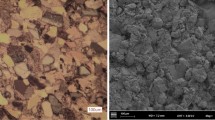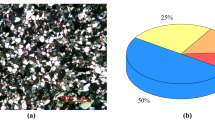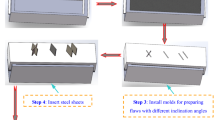Abstract
To investigate the mechanical properties and fracture mechanism of rocks containing multiple flaws after freeze–thaw (F-T) treatment, sandstone specimens with multiple flaws were prepared and subjected to F-T treatment and uniaxial compression tests. The global strain field on the specimen surface during the loading process was calculated using the digital image correlation (DIC) method, and four grayscale parameters were introduced to quantitatively characterize the evolution of the strain field. Then, the differentiation rates (DRs) of these parameters were defined, and the correlation between these parameters and the rock fracture state was analyzed. The F-T cycling deteriorated the mechanical properties and increased the strain concentration of the specimens. The calculation results of the horizontal strains at the measurement points along the crack propagation path showed that the crack initiation of the specimens after F-T treatment occurred earlier, and their brittle failure characteristics were less pronounced. The specimen fracture process was successfully described by combining DIC and statistical grayscale parameters. The evolution pattern of each grayscale parameter of the specimens was generally similar before and after F-T treatment in that it exhibited disorderly fluctuation first, then steady development, and finally accelerated change. The grayscale parameters changed abruptly at the initiation of wing cracks and antiwing cracks, resulting in sharp points in the DR vs. strain curves. These points can be defined as precursor points P1 and P2 for identifying the deformation and fracture state of the rock. The F-T cycling led to the delayed occurrence of P1 and the advanced occurrence of P2.



















Similar content being viewed by others
Data availability
The data that support the findings of this study are available from the corresponding author.
References
Altindag R, Alyildiz IS, Onargan T (2004) Mechanical property degradation of ignimbrite subjected to recurrent freeze-thaw cycles. Rock Mech Rock Eng 41:1023–1028
Bayram F (2012) Predicting mechanical strength loss of natural stones after freeze-thaw in cold regions. Cold Reg Sci Technol 83–84(12):98–102
Blaber J, Adair B, Antoniou A (2015) Ncorr: open-source 2D digital image correlation matlab software. Exp Mech 55:1105–1122
Cao RH, Cao P, Lin H, Ma GW, Fan X, Xiong XG (2018) Mechanical behavior of an opening in a jointed rock-like specimen under uniaxial loading: experimental studies and particle mechanics approach. Arch Civ Mech Eng 18:198–214
Cao RH, Wang CS, Yang RB, Hu T, Lei DX, Lin H, Zhao YL (2020) Effects of cyclic freeze-thaw treatments on the fracture characteristics of sandstone under different fracture modes: Laboratory testing. Thero Appl Fract Mec 109:102738
Chuter VN (2010) Relationships between foot type and dynamic rearfoot frontal plane motion. J Foot Ankle Res 3:9
Freire-Lista DM, Fort R, Varas-Muriel MJ (2015) Freeze-thaw fracturing in building granites. Cold Reg Sci Technol 113:40–51
Goodman RE (1989) Introduction to rock mechanics, 2nd edn. Wiley, London
Huang CC, Yang WD, Duan K, Fang LD, Wang L, Bo CJ (2019b) Mechanical behaviors of the brittle rock-like specimens with multi-non-persistent joints under uniaxial compression. Constr Build Mater 220(30):426–443
Huang SB, Liu YZ, Guo YL, Zhang ZL, Cai YT (2019a) Strength and failure characteristics of rock-like material containing single crack under freeze-thaw and uniaxial compression. Cold Reg Sci Technol 162:1–10
International Society for Rock Mechanics (ISRM) (2007) The complete ISRM suggested methods for rock characterization, testing and monitoring: 1974–2006. In: Ulusay R, Hudson JA (eds) Suggested methods prepared by the commission on testing methods, International Society for Rock Mechanics. Compilation Arranged by the ISRM Turkish National Group, Kozan Ofset, Ankara, Turkey
Jaeger JC, Cook NGW, Zimmerman RW (2007) Fundamentals of rock mechanics, 4th edn. Blackwell Publishing Ltd., UK
Lei RD, Zhang ZY, Berto F, Ranjith PG, Zhang CP (2021) Strain localization and cracking behavior of sandstone with two gypsum-infilled parallel flaws. Thero Appl Fract Mec 112:102873
Li YY, Cui HQ, Zhang P, Wang DK, Wei JP (2020) Three-dimensional visualization and quantitative characterization of coal fracture dynamic evolution under uniaxial and triaxial compression based on μCT scanning. Fuel 262:116568
Liu LW, Li HB, Li XF, Wu D, Zhang GK (2021b) Underlying mechanisms of crack initiation for granitic rocks containing a single pre-existing flaw: insights from digital image correlation (dic) analysis. Rock Mech Rock Eng 54(2):857–873
Liu TY, Zhang CY, Cao P, Zhou KP (2020) Freeze-thaw damage evolution of fractured rock mass using nuclear magnetic resonance technology. Cold Reg Sci Technol 170:102951
Liu TY, Zhang CY, Li JT, Zhou KP, Cao P (2021a) Detecting freeze–thaw damage degradation of sandstone with initial damage using NMR technology. Bull Eng Geol Environ 80(6):4529–4545
Luo XD, Jiang N, Zuo CQ, Dai ZW, Yan ST (2014) Damage characteristics of altered and unaltered diabases subjected to extremely cold freeze–thaw cycles. Rock Mech Rock Eng 47:1997–2004
Miao ST, Pan PZ, Li SJ, Chen JQ, Petr K (2021) Quantitative fracture analysis of hard rock containing double infilling flaws with a novel DIC-based method. Eng Fract Mech 252:107846
Miao ST, Pan PZ, Wu ZH, Li SJ, Zhao SK (2018) Fracture analysis of sandstone with a single filled flaw under uniaxial compression. Eng Fract Mech 204:319–343
Miao ST, Pan PZ, Yu PY, Zhao SK, Shao CY (2020) Fracture analysis of Beishan granite after high-temperature treatment using digital image correlation. Eng Fract Mech 225:106874
Momeni A, Abdilor Y, Khanlari GR, Heidari M, Sepahi AA (2016) The effect of freeze-thaw cycles on physical and mechanical properties of granitoid hard rocks. Bull Eng Geol Environ 75(4):1649–1656
Mutluturk M, Altindag R, Turk G (2004) A decay function model for the integrity loss of rock when subjected to recurrent cycles of freezing-thawing and heating-cooling. Int J Rock Mech Min Sci 41:237–244
Niu Y, Zhou XP, Zhang JZ, Qian QH (2019) Experimental study on crack coalescence behavior of double unparallel fissure-contained sandstone specimens subjected to freeze-thaw cycles under uniaxial compression. Cold Reg Sci Technol 158:166–181
OriginLab Corporation (2007) Origin 8 user guide. 1st edn, One Roundhouse Plaza, Northampton
Pan B, Qian KM, Xie HM, Asundi (2009) A two-dimensional digital image correlation for in-plane displacement and strain measurement: a review. Meas Sci Technol 20(6):062001
Park CH, Bobet A (2009) Crack coalescence in specimens with open and closed flaws: a comparison. Int J Rock Mech Min Sci 46(5):819–829
Park J, Hyum CU, Park HD (2015) Changes in microstructure and physical properties of rocks caused by artificial freeze–thaw action. Bull Eng Geol Environ 74:555–565
Peng HH, Fan JY, Zhang X, Chen J, Li ZZ, Jiang DY, Liu C (2020) Computed tomography analysis on cyclic fatigue and damage properties of rock salt under gas pressure. Int J Fatigue 134:105523
Qu DX, Li DL, Li XP, Luo Y, Xu K (2018) Damage evolution mechanism and constitutive model of freeze-thaw yellow sandstone in acidic environment. Cold Reg Sci Technol 155:174–183
Sagong M, Bobet A (2002) Coalescence of multiple flaws in a rock-model material in uniaxial compression. Int J Rock Mech Min Sci 39:229–241
Song YJ, Tan H, Yang HM, Chen SJ, Che YX, Chen JX (2021) Fracture evolution and failure characteristics of sandstone under freeze-thaw cycling by computed tomography. Eng Geol 294:106370
Stirling RA, Simpson DJ, Davie CT (2013) The application of digital image correlation to Brazilian testing of sandstone. Int J Rock Mech Min Sci 60:1–11
Takarli M, Prince W, Siddique R (2008) Damage in granite under heating/cooling cycles and water freeze–thaw condition. Int J Rock Mech Min 45(7):1164–1175
Tan XJ, Chen WZ, Yang DS, Dai YH, Wu GJ, Yang JP, Yu HD, Tian HM, Zhao WS (2014) Study on the influence of airflow on the temperature of the surrounding rock in a cold region tunnel and its application to insulation layer design. Appl Therm Eng 67:320–334
Tutluoğlu L, Öge IF, Karpuz C (2015) Relationship between pre-failure and post-failure mechanical properties of rock material of different origin. Rock Mech Rock Eng 48:121–141
Wang Y, Feng WK, Wang HJ, Li CH, Hou ZQ (2020a) Rock bridge fracturing characteristics in granite induced by freeze-thaw and uniaxial deformation revealed by AE monitoring and post-test CT scanning. Cold Reg Sci Technol 177:103115
Wang YX, Zhang H, Lin H, Zhao YL, Liu Y (2020b) Fracture behaviour of central-flawed rock plate under uniaxial compression. Thero Appl Fract Mec 106:102503
Wang Z, Zhu ZD, Zhu S (2019) Thermo-mechanical-water migration coupled plastic constitutive model of rock subjected to freeze-thaw. Cold Reg Sci Technol 161:71–80
Wong LNY, Li HQ (2013) Numerical study on coalescence of two pre-existing coplanar flaws in rock. Int J Solids Struct 50:3685–3706
Wong RHC, Chau KT (1998) Crack coalescence in a rock-like material containing two cracks. Int J Rock Mech Min Sci 35(2):147–164
Xu JM, Liu F, Chen ZY, Wu YJ (2017) Digital features of main constituents in granite during crack initiation and propagation. Eng Geol 225:96–102
Yang SQ (2011) Crack coalescence behavior of brittle sandstone samples containing two coplanar fissures in the process of deformation failure. Eng Fract Mech 78:3059–3081
Yang XX, Kulatilake PHSW (2016) Effect of joint micro mechanical parameters on a jointed rock block behavior adjacent to an underground excavation: a particle flow approach. Geotech Geol Eng 37:431–453
Yavuz H, Altindag R, Sarac S, Sengun N (2006) Estimating the index properties of deteriorated carbonate rocks due to freeze–thaw and thermal shock weathering. Int J Rock Mech Min Sci 43(5):767–775
Zhang K, Jiang Z, Liu XH, Zhang K, Zhu H (2022) Quantitative characterization of the fracture behavior of sandstone with inclusions: experimental and numerical investigation. Thero Appl Fract Mec 121:103429
Zhang K, Li N (2022) A new method to replicate high-porosity weak rocks subjected to cyclic freezing-thawing: sand 3D printing and digital image correlation explorations. Int J Rock Mech Min Sci 157:105174
Zhang K, Li N, Liu WL, Xie JB (2020b) Experimental study of the mechanical, energy conversion and frictional heating characteristics of locking sections. Eng Fract Mech 228:106905
Zhang K, Liu XH, Chen YL, Chen HM (2021b) Quantitative description of infrared radiation characteristics of preflawed sandstone during fracturing process. J Rock Mech Geotech 13(1):131–142
Zhang K, Qi FF, Bao R, Xie JB (2021a) Physical reconstruction and mechanical behavior of fractured rock masses. Bull Eng Geol Environ 80(6):4441–4457
Zhang L, Dang FN, Ding WH, Zhu L (2020a) Quantitative study of meso-damage process on concrete by CT technology and improved differential box counting method. Measurement 160:107832
Zhao YS, Gao YT, Wu SC (2020) Influence of different concealment conditions of parallel double flaws on mechanical properties and failure characteristics of brittle rock under uniaxial compression. Thero Appl Fract Mec 109:02751
Zhou XP, Li CQ, Zhou LS (2020) The effect of microstructural evolution on the permeability of sandstone under freeze-thaw cycles. Cold Reg Sci Technol 177:103119
Zhou XP, Lian YJ, Wong LNY, Berto F (2018) Understanding the fracture behavior of brittle and ductile multi-flawed rocks by uniaxial loading by digital image correlation. Eng Fract Mech 199:438–460
Zhou XP, Niu Y, Zhang JZ, Shen XC, Zheng Y, Berto F (2019) Experimental study on effects of freeze-thaw fatigue damage on the cracking behaviors of sandstone containing two unparallel fissures. Fatigue Fract Eng M 42(6):1322–1340
Funding
This work was supported by the National Natural Science Foundation of China (Grant Nos. 11902128, 41762021, and 11862024) and the Applied Basic Research Foundation of Yunnan Province, China (Grant No. 2019FI012).
Author information
Authors and Affiliations
Corresponding author
Ethics declarations
Competing interest
The authors declare no competing interests.
Rights and permissions
Springer Nature or its licensor (e.g. a society or other partner) holds exclusive rights to this article under a publishing agreement with the author(s) or other rightsholder(s); author self-archiving of the accepted manuscript version of this article is solely governed by the terms of such publishing agreement and applicable law.
About this article
Cite this article
Liu, X., Zhang, K., Liu, W. et al. Grayscale evolution characterization of the strain field and precursor identification in sandstone containing multiple flaws after freeze–thaw treatment. Bull Eng Geol Environ 82, 22 (2023). https://doi.org/10.1007/s10064-022-03044-9
Received:
Accepted:
Published:
DOI: https://doi.org/10.1007/s10064-022-03044-9




